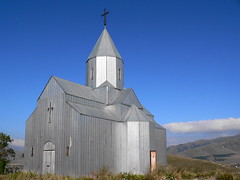On the way back to Yerevan on Tuesday afternoon, we drove through Spitak, epicenter of the 1988 earthquake that leveled huge portions of central northwest Armenia. The earthquake occurred in the morning. Many people were at work. Students were in school buildings. The earthquake destroyed countless buildings, burying their inhabitants. It killed more than 25,000 people.
Foreign assistance helped rebuild Spitak. As you drive through the town, you see that one of the best-kept and newest cities in Armenia has emerged from the tragedy.
We stopped at a church built in the Armenian traditional style, with one exception. Draped in uncharacteristic steel siding, the church was erected in about 45 days. The accelerated timetable was necessary to accommodate the thousands of funerals for Spitak's earthquake dead. Surrounding the church are tombstones in the traditional Soviet style, with pictures of the deceased etched into the stone (a feature now seen widely in Los Angeles, for example at the Hollywood Forever cemetery in CD13). The church is now abandoned, with a rusty lock that looks like it hasn't been opened in years. Like much of Armenia, Spitak would rather look to the future than back at the sadness of its past.
skip to main |
skip to sidebar

|
tags
Blog Archive
- September 2011 (18)
- August 2011 (20)
- July 2011 (27)
- June 2011 (24)
- May 2011 (39)
- April 2011 (26)
- March 2011 (47)
- February 2011 (28)
- January 2011 (14)
- December 2010 (25)
- November 2010 (13)
- October 2010 (23)
- September 2010 (12)
- August 2010 (6)
- July 2010 (12)
- June 2010 (10)
- May 2010 (13)
- April 2010 (30)
- March 2010 (30)
- February 2010 (32)
- January 2010 (35)
- December 2009 (27)
- November 2009 (24)
- October 2009 (31)
- September 2009 (25)
- August 2009 (36)
- July 2009 (31)
- June 2009 (43)
- May 2009 (25)
- April 2009 (37)
- March 2009 (28)
- February 2009 (21)
- January 2009 (22)
- December 2008 (16)
- November 2008 (10)
- October 2008 (15)
- September 2008 (14)
- August 2008 (5)
- July 2008 (16)
- June 2008 (17)
- May 2008 (12)
- April 2008 (15)
- March 2008 (8)
- February 2008 (10)
- January 2008 (8)
- December 2007 (12)
- November 2007 (10)
- October 2007 (13)
- September 2007 (13)
- August 2007 (7)
- July 2007 (17)
- June 2007 (12)
- May 2007 (24)
- April 2007 (18)
- March 2007 (16)
- February 2007 (9)
- January 2007 (18)
- December 2006 (11)
- November 2006 (8)
- October 2006 (15)
- September 2006 (16)
- August 2006 (11)
- July 2006 (14)
- June 2006 (19)
- May 2006 (13)
- April 2006 (6)
- March 2006 (14)
- February 2006 (11)
- January 2006 (15)
- December 2005 (9)
- November 2005 (11)
- October 2005 (12)
- September 2005 (10)
- August 2005 (29)
- July 2005 (13)
- June 2005 (20)
- May 2005 (22)
- April 2005 (30)
- March 2005 (21)
- February 2005 (3)
